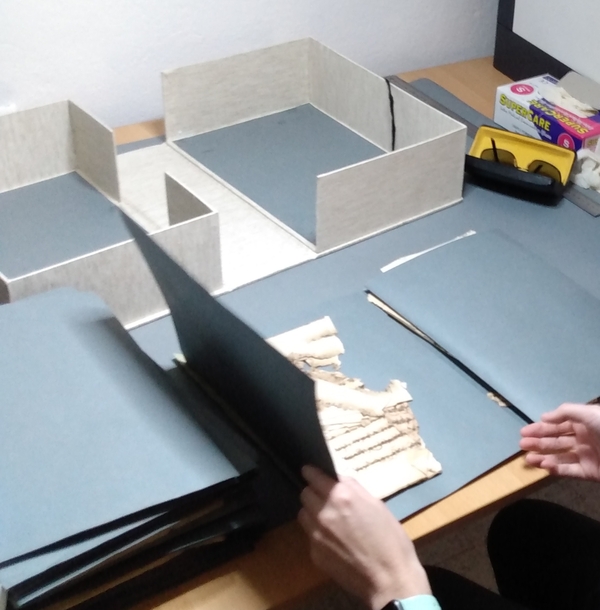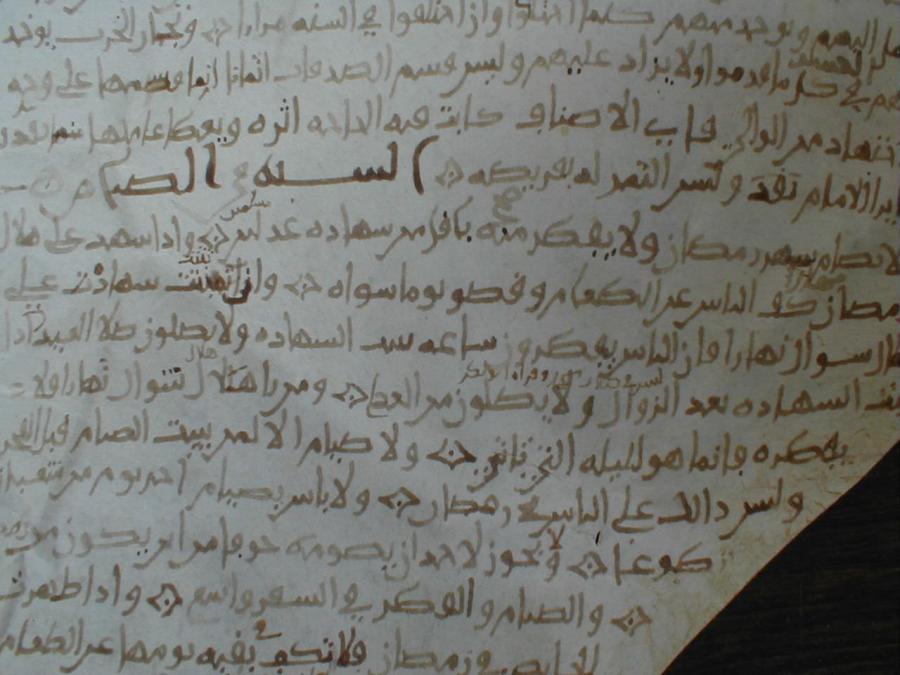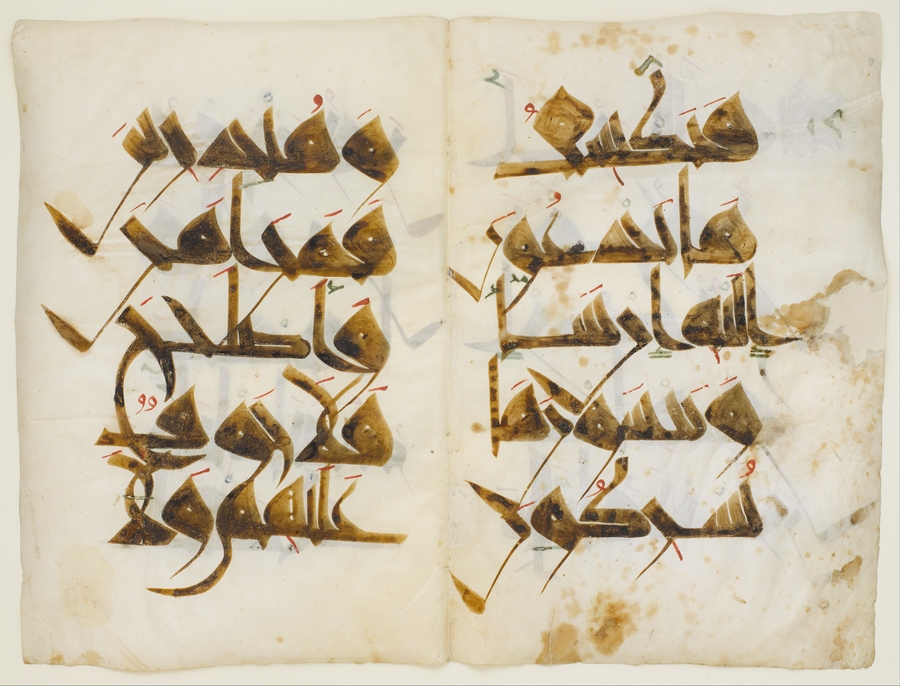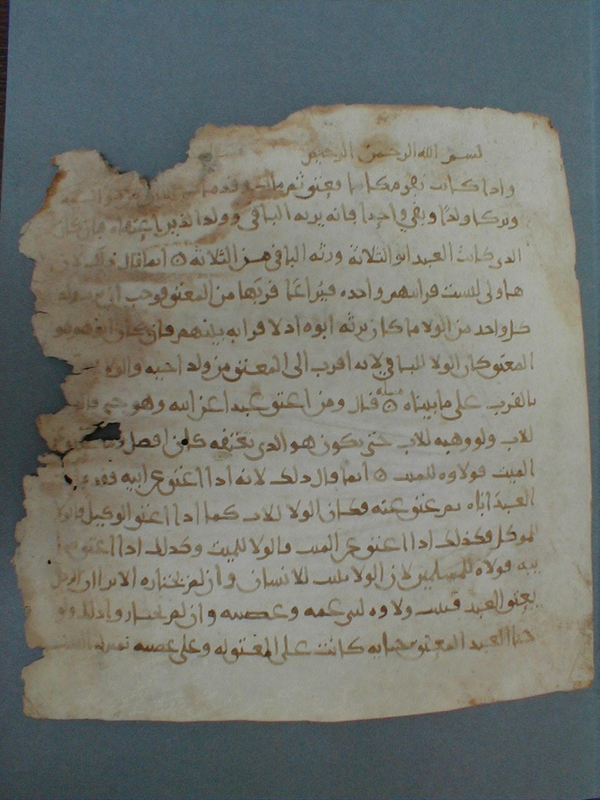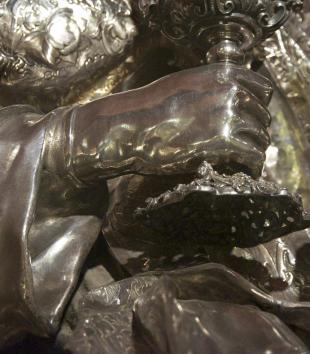Jonathan E. Brockopp is Professor of History, Religious Studies, and Philosophy at the Pennsylvania State University. His current project is a history of the Kairouan collection, provisionally titled The Writerly Cultures of Kairouan: a Mediterranean story.
In April of 2000, I sat with Shaykh al-Ṣādiq Mālik al-Gharyānī in the Sīdī ʿAbīd mausoleum in Kairouan, Tunisia, going through boxes of loose parchment folios originally from the Great Mosque of Kairouan (Fig. 1).1 In front of me was yet another bifolio on rough parchment with no date, no author and no title, but this time I recognized the script from a different manuscript fragment I had seen. With the Shaykh’s help, I eventually found four bifolios in three different boxes, with idiosyncratic Arabic handwriting that suggested a common scribe. Measurements of the parchment (approximately 28 x 18 cm with some variation) and of the sewing stations confirmed that all three fragments originated from the same quire. The parchment is heavy, strong, and has endured the test of time, but it is not of high quality. Every portion of the skin was used in production, and there are imperfections that evoke the animal whose skin this once was. Small holes may have been caused by the larvae of a parasitic fly that settled on the animal while it was still alive, and the uneven lower right edges trace the line of the animal’s shoulder (see Fig. 2). That these defects are original to the parchment, and not later damage, is confirmed by the fact that the scribe carefully wrote around them. In areas of later damage, by contrast, both parchment and text are missing.
- 1Now stored at the NLPCPM in Raqqada, just outside Kairouan. The staff is in the process of producing a new inventory, and in June of 2022 I was able to see these three fragments again and confirm their serial numbers; they are milaff (folder) 35, number 14/94, milaff 49, number 2/915, and milaff 75, number 13/764.
The iron-gall ink, now faded to brown, is still quite legible, with twenty-five to thirty-four lines per page. The script is old and angular; in a private communication from May 30, 2020, Humberto Bongianino suggested “its angularity harks back to the script of 9th-century literary papyri from Egypt and is typical of the purest Qayrawānī tradition (‘Ifrīqī scripts,’ as Ibn Khaldun called them).” There are almost no margins. A few corrections are found interlinearly and in the slim margins; combined with a number of minor transmission errors, these suggest that the manuscript may have been written by a student as part of a course of instruction. They also offer our first clue as to the identity of the text.
After the chapter headings, the original scribe returned to the manuscript and added in the margins or squeezed in between lines “ʿAbdallāh ibn ʿAbd al-Ḥakam said.” This phrase must refer to the well-known Egyptian legal scholar and historian, Abū Muḥammad ʿAbdallāh Ibn ʿAbd al-Ḥakam who was born in Alexandria in 771 CE and lived most of his life in Fusṭāṭ (now a neighborhood in the south of metropolitan Cairo), where he died in 829 CE. He is said to have written a number of important texts, and his Major Compendium of Jurisprudence is well-attested with many manuscript witnesses, but the text of this manuscript does not match that work.1 At several places, other annotations refer to a certain Muḥammad, and one marginal note marks a short passage and explains that this passage was not part of “Muḥammad’s version (kitāb).” At another place, a passage is marked and written above the line is the explanation “This is not in Muḥammad’s version, but Abū Bakr recited it” (see Fig. 3). References to this Muḥammad are not frequent, and they include additional proofs, occasionally from ḥadīth, for positions asserted in the text. Compiling all these notes, I discovered this was the son of the author, Muḥammad b. ʿAbdallāh b. ʿAbd al-Ḥakam, who died in 268/882 and who is well-known as a transmitter of his father’s work, but as I will discuss below, the identity of “Abū Bakr” has remained a mystery until now.
- 1Jonathan Brockopp, Early Mālikī Law: Ibn ʿAbd al-Ḥakam and his Major Compendium of Jurisprudence (Leiden: Brill, 2000), 81-90.
After a bit of research and some luck, I was able to identify this fragment as a section of Ibn ʿAbd al-Ḥakam’s Minor Compendium [of Islamic law], one of several examples of early Islamic texts that are known to us only through manuscripts preserved in Kairouan.1 But this is no isolated fragment found with other “Oriental” manuscripts in some European library. Rather, it is part of one of the most important collections of Islamic manuscripts in the world, and the conservation laboratory where it is now kept is only a few kilometers from where this manuscript was originally produced. In other words, this fragment is in situ, part of a collection of hundreds of manuscripts that has remained largely intact for over 1,000 years. This rich context allows us to approach this manuscript fragment not only as a text but as also a material object, providing new insights into the activities of Muslim scholars during the formative period of Islamic law and theology.
- 1Jonathan Brockopp, “The Minor Compendium of Ibn ʿAbd al-Ḥakam (d. 214/829) and its reception in the early Mālikī school,” Islamic Law and Society 12, no. 2 (2005): 149-181.
For example, while the roughness of this parchment fragment does not seem to have been unusual in Kairouan, it is intriguing. The Kairouan collection contains many early texts on Islamic law, theology, and Qur’an commentary, and most of the early ones are written on a similar grade of parchment. Twenty-three of these can be confidently dated to AH 293 (906 CE) or earlier, based on colophons and readers’ remarks that also help to document the highly organized scholarly activity in this city.1 In contrast, fine Qur’ans, also produced in Kairouan a century or so later, use a much higher grade of parchment (Fig. 4). The script on Kairouan Qur’an manuscripts is more formalized and exquisitely beautiful, with far more attention given to fine production and significantly fewer words per page. This demonstrates that during the tenth and eleventh centuries, Muslim scholars were writing in two very different ways: as a utilitarian method of recording and teaching knowledge, and as a painstaking, expensive devotional activity that resulted in some of the most beautiful Qur’an manuscripts in the world.
- 1Jonathan Brockopp, Muhammad's Heirs: The Rise of Muslim Scholarly Communities, 622-950 (Cambridge: Cambridge University Press, 2017), 199-209. While Kairouan has two examples of paper from the ninth century, it is not commonly used until after the tenth century.

Fig. 5. The Maqsura. By Tab59 - Flickr: Grande Mosquée de Kairouan, CC BY-SA 2.0.
In comparison with the famous cities of Cordoba and Cairo, Kairouan may seem an unlikely location for such a collection. Once the capital of the rich province of “Ifrīqiyya” (Roman Africa), its fortunes were eclipsed by these other cities already by the mid-eleventh century. But in many ways its isolation, and its relatively arid climate, helped to preserve this treasure trove of manuscripts. Getting to Kairouan today requires an hour’s drive over well-paved roads from Sousse on Tunisia’s Mediterranean coast. The rolling plains are lush with wheat fields and olive groves in winter, dry and dusty in the summer. This was the same route that local dignitary Muhammad Bek Bayram VI used when he traveled to Kairouan in 1896 by horse-drawn tram. Bayram was a scion of a cultured family who kept up with antiquarian trends and collaborated with the French protectorate then ruling the country. In an article published in a leading Arabic literary journal the following year, he described his journey to Kairouan and his discovery of these manuscripts in the maqṣūra of the great mosque of Kairouan.1
The maqṣūra, a space at the front of the mosque enclosed by a tall wooden screen, was a controversial construction, meant to shield the local ruler from the masses, providing both security and privacy. Unusually, Bayram described a second maqṣūra inside this first, probably referring to a small room built into the qibla wall to the right of the minbar; it had two cabinets and artifacts from Kairouan’s history strewn on the ground. In the cabinets were tied bundles of parchment leaves, piled helter-skelter next to partly bound volumes of ancient Qur’ans, all covered with thick dust and spider webs.2
In his description, Bayram is most taken with these Qur’ans, many of which are stunning examples of Muslim devotional art, including the famous Blue Qur’an. Single pages of this masterpiece, written with gold ink on rare, blue-dyed parchment, are now found in museums all over the world, but Tunisia retains the majority of the preserved leaves of the manuscript and proudly displays portions in the National Museum of Art and Architecture in Tunis.
Outside of some Qur’an pages, very little of this collection found its way into British and French colonial hands. Most of it remained intact, and Bayram saw to it personally that the authorities intervened to save this irreplaceable piece of world heritage from ruin. Local scholars gathered the manuscript fragments together in the early-twentieth century and placed them in leather folders (milaffāt). Today, leather folders have been exchanged for acid-free preservation boxes, but the fragments remain in their disorganized state. This helps to explain why this fragment of Ibn ʿAbd al-Ḥakam’s Minor Compendium is now found in three different boxes.
So, we are left with a conundrum. On the one hand, early Muslim scholars of Kairouan clearly treated literary texts on Islamic theology and law quite differently than the Qur’an. But on the other hand, this manuscript of Ibn ʿAbd al-Ḥakam’s Minor Compendium, and many others like it, was considered valuable enough to be stored with these exquisite Qur’an manuscripts in the maqṣūra at the front of the great mosque. From contemporaneous accounts, we know that scholars were encouraged to donate texts to this collection, and a register dating to the year 693/1294 describes dozens of manuscripts and provides further evidence that they were considered part of a collection. A study of endowment notes on the manuscripts further elucidates the continuous use of this collection up to the early Ottoman period, with more manuscripts added over time.1 As I have suggested elsewhere, part of the reason that these simple legal manuscripts were linked together with far more expensive Qur’ans may have to do with an elevation in the status of the legal expert, but much more work needs to be done to fully explain this phenomenon.2
The rich context of this collection opens up many questions, but it also provides some surprisingly specific answers. For instance, it helps solve the identity of Abū Bakr, the authority in the remark mentioned above: “This is not in Muḥammad’s version, but Abū Bakr recited it (qaraʾahu).” Again, the interlinear notes suggest that this manuscript was collated from at least two different sources, the original and “Muḥammad’s version,” and Muḥammad refers to Ibn ʿAbd al-Ḥakam’s son, who is known to have transmitted his father’s work. To my knowledge, the unusual script of the manuscript of Ibn ʿAbd al-Ḥakam’s Minor Compendium is found in only one other parchment fragment, also in Kairouan and stored under serial number 6400 (Fig. 7). This fragment is a single page from a commentary on Ibn ʿAbd al-Ḥakam’s Major Compendium by Abū Bakr al-Abharī, an important Baghdadi scholar of the Mālikī school who died in 375/985. As we know from historical accounts, Abū Bakr al-Abharī wrote commentaries on both Ibn ʿAbd al-Ḥakam’s Major and his Minor Compendium, and maintained an important correspondence with experts in Kairouan, including Ibn Abī Zayd al-Qayrawānī (d. 386/996). It seems likely, then, that the scribe of fragment number 6400 also consulted a copy of Ibn ʿAbd al-Ḥakam’s Minor Compendium, now lost, that was “recited by” Abū Bakr al-Abharī.
Fragment number 6400 is thus a witness to the international status of Kairouan in the tenth century. In Baghdad, the bookseller Ibn al-Nadīm made a list of many thousands of titles of books in Arabic that he knew of or had seen personally in 988 CE, including commentaries on Ibn ʿAbd al-Ḥakam’s texts by Abū Bakr al-Abharī, who was Ibn al-Nadīm’s contemporary in Baghdad. To have manuscript fragments from Kairouan that can be dated roughly to Ibn al-Nadīm’s own time is extraordinary evidence of the efficient paths by which knowledge traveled throughout the Mediterranean.1 While these fragments of Ibn ‘Abd al-Ḥakam’s work have no dates, they reside among some of the oldest Islamic manuscripts in the world, allowing for contextual analysis of parchment, ink, and calligraphy that is not possible elsewhere. These artifacts are direct witnesses to the early flourishing of Arabic writing and just one example of the ways that manuscripts in this collection interact with one another, revealing much about the community of scholars that produced them.
There are many important collections of Islamic manuscripts; those of Timbuktu, for example, captured the attention of the world, especially when that collection was attacked by members of the rebel Jihadi organization Ansar Dine in 2013. Others include a large cache of extremely early Qur’an manuscripts in Yemen; an unusual collection that derives from the treasury chamber of the Umayyad mosque in Damascus; the university libraries of al-Azhar (Egypt) and al-Qarawiyyīn (Morocco); and the thousands of manuscripts collected by the Ottoman sultans, now found in Istanbul. European collectors, taking advantage of colonial occupation, also spirited away important manuscripts, creating significant collections in their national libraries. These manuscripts bear witness to a history of literary and cultural production in the Islamic world that was unrivaled in medieval Europe. From Cordova to Cairo to Baghdad, Muslim historians, poets, and scientists produced an astonishing array of Arabic texts, only some of which have been edited and published. But with the exception of very early Qur’ans, most of these manuscripts are relatively recent copies, written long after the original text was composed. Only in Kairouan do we have so many non-Qur’anic manuscripts produced at such an early date.
Today, the Kairouan collection is maintained by the National Heritage Institute in a conservation laboratory behind the Museum of Islamic Arts in Raqqada, just south of Kairouan (Fig. 8). There, technicians painstakingly conserve these ancient fragments, crown jewels in the considerable cultural treasure of this vibrant young democracy. Our knowledge of this collection is still rudimentary, and many loose folios await identification and study. A material analysis of these rare documents from Kairouan—the oldest, intact collection of Arabic literary manuscripts that we know of—promises to reveal much about the way Islamic law and theology were studied, as well as the value given to these subjects by early Muslim scholars.
- 1Interestingly, the oldest-known fragment from Abū Bakr al-Abharī’s commentary on Ibn ‘Abd al-Ḥakam’s Major Compendium, collated in 1014 CE (405 AH), is also the earliest dated legal manuscript in al-Azhar University Library in Cairo (ms. Azhar, fiqh mālikī 1655); see Brockopp, Early Mālikī Law, 212-3.
To learn more about research into the Kairouan Manuscripts, see http://hdl.handle.net/10079/824fbb4f-4c93-4feb-ae8c-abdd33550332.
Research on these manuscripts was supported by the Fulbright Commission, the Centre for the Study of Manuscript Cultures (Universität Hamburg), and Penn State University. I am grateful to the staff and administrators at the Tunisian National Heritage Institute and the National Laboratory for the Preservation and Conservation of Parchment and Manuscripts (NLPCPM) for facilitating my work with the collection, and to the editor and anonymous readers for their comments on an earlier version of this essay.
Notes
Imprint
10.22332/mav.obj.2022.3
1. Jonathan E. Brockopp, "A tenth-century Islamic manuscript from Kairouan, Tunisia," Object Narrative, MAVCOR Journal 6, no. 2 (2022), doi: 10.22332/mav.obj.2022.3.
Brockopp, Jonathan E. "A tenth-century Islamic manuscript from Kairouan, Tunisia." Object Narrative. MAVCOR Journal 6, no. 2 (2022), doi: 10.22332/mav.obj.2022.3.
